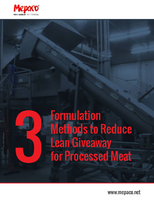Natural Gas Dehydration Facility Adds SIS to Prevent Dangerous Overpressures
Share:
At a facility for dehydrating large volumes of raw natural gas from wells, engineers designed a Safety Instrumented System (SIS) of SIL-2 to help protect low-pressure pipe and process equipment against overpressures. Components of the SIS include a PLC logic solver, ABB 2600T pressure transmitters, and pneumatically actuated ball valves.
Removing water
Located near a field of producing wells in western USA, the facility has safety critical points at each of several manifolds that share the total flow of raw gas being processed. One such manifold, as indicated Figure 1, has gas inputs coming through pipes from five wells in one area of the well field. Gas from the wells ranges in pressure up to 3,000 psi in insulated, underground pipe specified for these high pressures.
The diagram indicates removal of free and entrained water in two consecutive process steps. Both steps occur in pipe and vessels rated at 1,600 psi, which must be protected from possible pressure excursions at the manifolds. Once free and entrained water is removed from the natural gas, it flows via pipeline to another plant that separates it into such products as methane, carbon dioxide, hydrogen sulfide, nitrogen, and helium. Dehydration and separation of the raw gas are normally continuous processes occuring in sequence.
Originally, the dehydration facility operated with a basic Distributed Control System (DCS) to reduce gas pressures at the manifolds to 1,500 psi, as required to remove free water. The facility depended on pressure safety valves installed within the downstream process areas to shunt any overpressure gas to a flare stack.
Protecting lower pressure equipment
Growing demands for natural gas resulted in upstream supply pressures at the manifolds to near the maximum allowable. At this point engineers conducted a risk analysis study that indicated need for independent SIS protection at piping locations vulnerable to serious overpressures. The risk study also determined that a Safety Integrity Level (SIL) of 2 would be sufficient for all the components of an SIS -- sensor, logic solver, and final control element.
In this application, the SIS sensors are a pair of electronic DP transmitters from ABB to measure each critical pressure point -- set at 1,510 psi on a PLC SIL 2 logic solver. The final control elements are ball valves installed in each high-pressure supply pipe -- two valves in series to provide proper SIL for safety shut-off in case of overpressure.
The facility chose ABB 2600T series pressure transmitters having SIL-2 ratings certified by the German test agency TUV. SIL-2 pressure transmitters work in pairs to monitor safety critical points. A pair of ABB SIL-2 rated pressure transmitters offers the same protection as three redundant conventional pressure transmitters.
Generally the installed and operating cost of specialized transmitters is far less than that of the required conventional transmitters to meet a specific SIL value. Set at 1510 psi the SIS catches an overpressure condition and shuts the ball valves in the high pressure piping within affected manifolds. This action takes place before any pressure safety valve vents, eliminating this possible source of undesirable emissions.
ABB (www.abb.com) is a leader in power and automation technologies that enable utility and industry customers to improve their performance while lowering environmental impact. The ABB Group of companies operates in around 100 countries and employs about 107,000 people.
For more information please contact:
ABB
Rob Mapleston
Tel: 1-215-674-6580
or
1-800-829-6001
robert.mapleston@us.abb.com
www.abb.com/instrumentation




